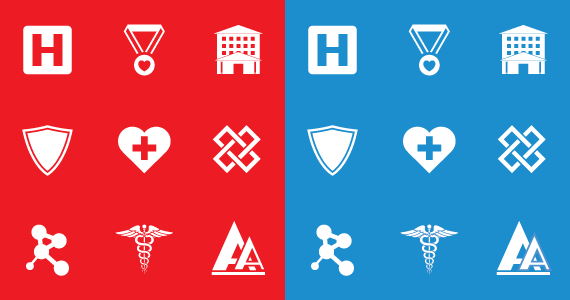Does a logo make a healthcare brand?
An exercise in brand perception
This post involves a little interactive exercise on healthcare brands, logos and perceptions. You’ll need a piece of paper and pencil (colored markers are helpful, but not necessary).
PART ONE: THE LOGO
Think quick: Try to picture the logos used by at least two national healthcare brands, such as the Mayo Clinic; Cleveland Clinic, Roswell Park, or Sloan Kettering. Can you sketch any of these (without searching Google) or name the colors used in the designs?
Now visualize the logos for Blue Cross Blue Shield and the American Red Cross. Pretty easy, right? These logos are a direct representation of the shape and color communicated in the name. Not many healthcare brands are lucky enough to have such strong verbal and visual connections.
Next, visualize the logo of a local hospital network, physician group or health insurance company. Try sketching the logo. What is its shape or color? Is the typeface bold, thin, serif or san serif? Is the logo a wordmark or does it include a symbol?

PART TWO: THE BRAND
Write down any words that come to mind describing the national and local healthcare brand discussed above. Here are some ideas to get you going: What do they do? Are they known for an expertise or specialty?
Now think about your perceptions of the brands. What does each brand stand for? What is your opinion of each brand? Are there tag lines or headlines from their advertising campaigns that you can remember?
PART THREE: THE PERCEPTION
Based on your recollection of logos and brand positions, which memory was stronger for you? Was it the logo visualization or the verbal description of the brand?
Everybody is a little different, of course, and your experience with a brand can influence your memory or perceptions, but this exercise illustrates an important principle of healthcare marketing communication:
A strong logo supports a strong brand, but a strong logo is not necessarily able to change public opinion about a weak brand. The true function of a logo does not sell; it identifies.As design legend Paul Rand once stated, a logo derives its meaning from the quality of the thing it symbolizes, not the other way around. “It is only by association with a product, a service… that a logo takes on any real meaning,” he said. “If a company is second rate, the logo will eventually be perceived as second rate. Only after it becomes familiar does a logo function as intended; and only when the product or service has been judged effective or ineffective, suitable or unsuitable, does it become truly representative.”
